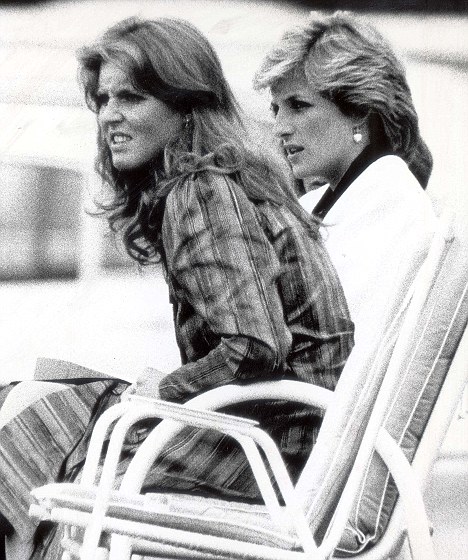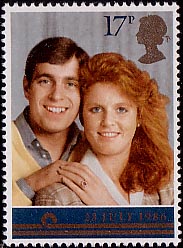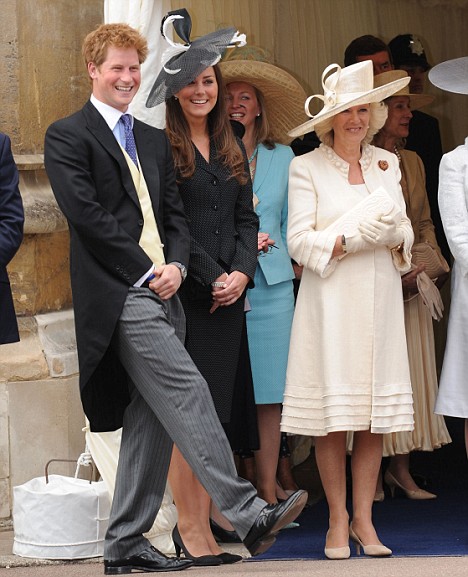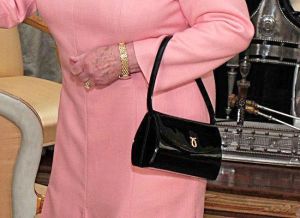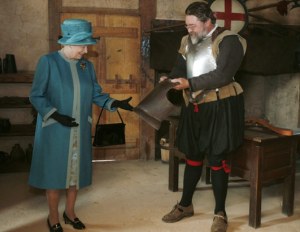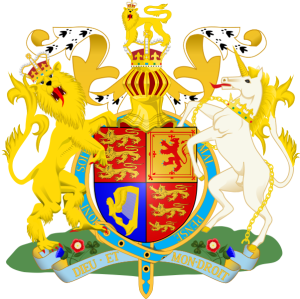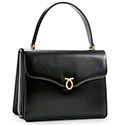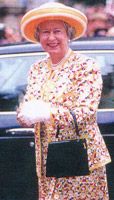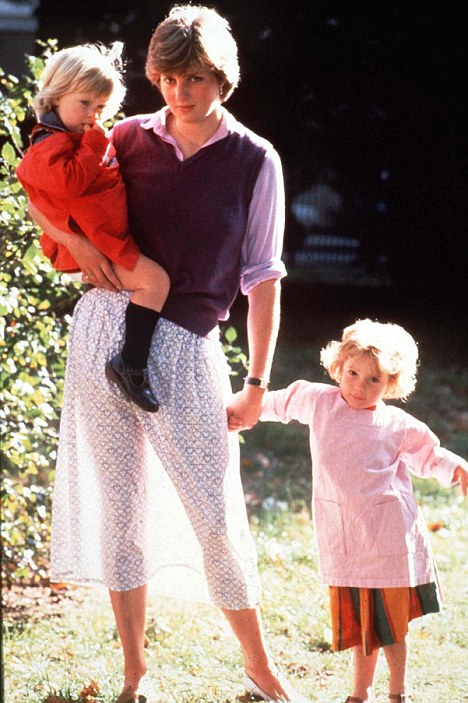
Lady Diana Spencer was a nanny and nursery school teacher prior to her marriage to Charles, Prince of Wales. Photo: fall, 1980
Lady Diana Spencer was understandably nervous about marrying Charles, Prince of Wales (b. 1948). Following their February 24, 1981, engagement announcement, Diana’s whole world was turned upside down. In a flash, nineteen-year-old Diana went from part-time nanny and nursery school teacher to the future Queen of England. Two days later, she kissed freedom goodbye forever. “Shy Di” moved out of her flat at No. 60 Coleburne Court, said a hasty goodbye to her 3 giddy roommates, and moved into Buckingham Palace, where she was sequestered for the five months leading up to her July 29 wedding, protected from the press. (1)

In their first public appearance together following their February 1981 engagement announcement, Lady Diana Spencer and Prince Charles attended a Royal Opera benefit at London's Goldsmith Hall. Lady Diana shocked the crowd by appearing in a low-cut, strapless black taffeta evening gown. "The Dress" made headlines: "Lady Di Takes the Plunge," screamed the front page of The Daily Mirror, with splendid photos of "Shy Di" spilling out of her revealing gown.
Throughout the spring, the Palace courtiers gave Diana lessons on how to be a princess. They advised her of her royal engagements, which would average 170 a year and would include Ascot, Trooping the Color, Badminton Horse Trials, Opening of Parliament, Chelsea Flower Show, Wimbledon, hospital benefits, charities, and anything for the military. They guided her through the maze of royal rules: wear hats in public and bright colors to stand out; wave from the elbow, not the wrist; never use a public lavatory.
‘The worst thing about being a princess,’ said Diana years later, ‘is having to pee.'”(1)
They handed her stacks of history books to read about her future role as Princess of Wales.

27th March 1981: Charles, Prince of Wales, his fiancee Lady Diana Spencer, and Queen Elizabeth II at Buckingham Palace, London, after she gave her consent for their wedding.
It was all too much for Diana. She longed to be with Charles, who was often unavailable, having embarked on a 5-week tour of the United States, Australia, and New Zealand, among his other royal duties. The Royal Family – when they were at the Palace, each with their own separate apartments – did nothing to help her feel at home. In fairness, each of the royals did have their own very busy schedules. Nevertheless, Diana was cut off from ordinary companionship. She felt insecure, lonely, and afraid.
I missed my girls [roommates] so much I wanted to go back there and sit and giggle and borrow clothes and chat about silly things, just being in my safe shell again….I couldn’t believe how cold everyone was [at Buckingham Palace].” (2)

Lady Diana Spencer (l.) walks with Camilla Parker-Bowles at Ludlow Racecourse in 1980, where Prince Charles was competing.
Along with palace isolation and wedding jitters, Diana agonized over whether Charles was still in love with his married mistress, Camilla Parker Bowles, although Charles swore their affair was a thing of the past. How could that be true, wondered Diana. Camilla telephoned Charles constantly and he always took her calls in private. Camilla and her husband were often included as weekend house guests at Sandringham, the royal family country house. Camilla haunted Diana and Charles’s courtship days.
Diana befriended Charles’s righthand man, Michael Colborne, peppering him with questions about Charles’s relationship with Camilla. Diana became bulimic from the worry and lost twenty pounds in just three months. She became weak and emotionally labile.

Camilla Shand as a debutante in 1965. She and Prince Charles met in 1970 and considered marriage. Lord Louis Mountbatten advised Charles against marrying the love of his life, citing Camilla's wild past and lack of aristocratic lineage.
Her fears over Camilla increased when, tucked among the wedding presents in the office Diana shared with Colborne, Diana discovered a curious little parcel. Over fierce objections from Colborne, she opened it, only to discover a gold bracelet with a lapis pendant engraved with the initials “F” and “G” entwined.
Diana became enraged. She knew the significance of the two letters: earlier friends had informed her that “F” and “G” stood for “Fred and Gladys,” the pet nicknames Charles and Camilla had for each other. Diana pressed Colborne about the gift:
‘I know it’s for Camilla,’ she said. ‘So why won’t you admit it? What does it mean? Why is Charles doing this?'” (2)
Colborne refused to answer any more questions, other than to admit that he had ordered the gift at Charles’s request. Diana was livid with jealousy.
She confronted Charles. He said he had indeed ordered the bracelet from Asprey’s for Camilla and was going to give it to her in person to signal the end of their relationship. He maintained it was a farewell gift but Diana didn’t believe him. They quarreled and she withdrew in tears.
The wedding day was bearing down on Diana like a freight train. Her fairytale was morphing into a nightmare. There wasn’t time enough to process all the change that was taking place in her young life.
Her weight plummeted. She became wisp-thin. Her bridal gown with its 25-foot train, puffy sleeves, and ivory taffeta was almost ready, although the dressmakers had to keep taking in the seams due to Diana’s dramatic weight loss. Between the first and last fittings, Diana’s waist shrank from 29 inches to 23-and-a-half inches.
In June, two weeks before her wedding, Diana attended Ascot Week where she was treated by the public and the media like an international film star.
Everyone was fascinated with this new breed of royalty. Diana was fresh, lovely, and natural. She had a real English rose complexion. Her larkiness was such a refreshing change of pace from the stodgy Royal Family with all their rules and stiffness.
But the crush of the crowd and the press, who trailed her at every outing, distressed Diana:
‘During tea at the back of the royal box at the races she was practically in tears and had to be escorted home early.'” (3)

Lady Diana Spencer watches Prince Charles play polo at Tidworth during their engagement. The wedding is four days later. Photo: July 25, 1981
On Monday, July 28, 1981, the day before her wedding, Diana lunched with her sisters while Charles met with Camilla with the gift. Diana confided to her sisters that she didn’t want to marry someone who was still in love with his mistress.
‘It’s bad luck, Duch,’ said her sister Sarah, using the family nickname for Diana. “Your face is on the tea towels, so you’re too late to chicken out now.”” (2)

It was too late to chicken out by the time Lady Diana Spencer considered breaking her engagement to Prince Charles. Her face was on the tea-towels already.
As Sarah pointed out, it was too late. England was awash in kitchy wedding memorabilia featuring the royal couple’s photos. London was crawling with tourists and international journalists and television crews. Sadly, there was no turning back for Diana.
The wedding went ahead as scheduled at St. Paul’s Cathedral. The Queen had sent 2,500 invitations to friends, families, and heads of state, plus the crowned heads of Europe. The ceremony was telecast to 750 million people. On that July day, Lady Diana Spencer (1961-1997) became newly titled as Diana, Princess of Wales. She outranked all other women in the realm, except Queen Elizabeth II and the Queen Mother. (1)

Wedding Bells chimed on July 29, 1981, when Lady Diana Spencer married Charles, Prince of Wales, at St. Paul's Cathedral in London.
Diana was right to have been worried about Camilla breaking up her marriage. Shortly after marrying Diana – some say five years later, others, that they never stopped seeing each other – the Prince resumed his relationship with Camilla. The marriage was long over before the royal Wales divorced in 1996.
(1) Kelley, Kitty. The Royals. New York: Warner Books, Inc., 1997.
(2) Morton, Andrew. Diana – Her True Story – In Her Own Words. Michael O’Mara Books, Ltd., 2003.
(3) Bradford, Sarah. Elizabeth: A Biography of Her Majesty The Queen. New York: Riverhead Books, 1996.
Readers: For more on Princess Diana, click here.











